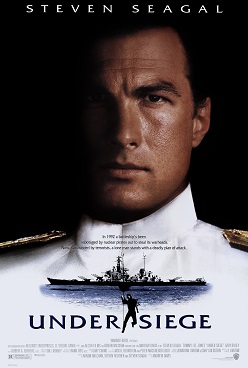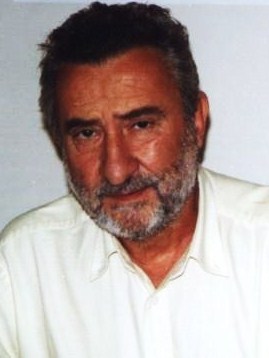
The spaghetti Western is a broad subgenre of Western films produced in Europe. It emerged in the mid-1960s in the wake of Sergio Leone's filmmaking style and international box-office success. The term was used by foreign critics because most of these Westerns were produced and directed by Italians.

Under Siege is a 1992 American action thriller film directed by Andrew Davis, written by J. F. Lawton, and starring Steven Seagal as a former Navy SEAL who must intercept a group of mercenaries, led by Tommy Lee Jones, after they commandeer the U.S. Navy battleship Missouri.

North by Northwest is a 1959 American spy thriller film produced and directed by Alfred Hitchcock, and starring Cary Grant, Eva Marie Saint, and James Mason. The screenplay was by Ernest Lehman, who wanted to write "the Hitchcock picture to end all Hitchcock pictures".

Sword-and-sandal, also known as peplum, is a subgenre of largely Italian-made historical, mythological, or biblical epics mostly set in the Greco-Roman antiquity or the Middle Ages. These films attempted to emulate the big-budget Hollywood historical epics of the time, such as Samson and Delilah (1949), Quo Vadis (1951), The Robe (1953), The Ten Commandments (1956), Ben-Hur (1959), Spartacus (1960), and Cleopatra (1963). These films dominated the Italian film industry from 1958 to 1965, eventually being replaced in 1965 by spaghetti Western and Eurospy films.

Aristide Massaccesi, known professionally as Joe D'Amato, was an Italian film director, producer, cinematographer, and screenwriter who worked in many genres but is best known for his horror, erotic and adult films.

Richard Harrison is an American actor, writer, director and producer known for his work in European B-movies during the 1960s and 1970s, and exploitation films of the early 1970s.

Brianne Sidonie Desaulniers, known professionally as Brie Larson, is an American actress. Known for her supporting roles in comedies as a teenager, she has since expanded to leading roles in independent films and blockbusters. She has received various accolades, including an Academy Award, a Golden Globe Award, and a Primetime Emmy Award. Time magazine named her one of the 100 most influential people in the world in 2019.

Cosimo III de' Medici was Grand Duke of Tuscany from 1670 until his death in 1723, the sixth and penultimate from the House of Medici. He reigned from 1670 to 1723, and was the elder son of Grand Duke Ferdinando II. Cosimo's 53-year-long reign, the longest in Tuscan history, was marked by a series of laws that regulated prostitution and May celebrations. His reign also witnessed Tuscany's deterioration to previously unknown economic lows. In 1723, when Cosimo died, he was succeeded by the younger of his two surviving children, Gian Gastone.
Romano Kristoff is a Spanish actor, writer and director, better known for his work in Filipino cinema. He worked mostly in the Philippines between the 1980s and early 1990s. He was also credited as Rom Kristoff, Ron Kristoff, Run Kristoff, Ron Krastoff, and other similar variants.

The cinema of North Korea began with the division of Korea and has been sustained since then by the ruling Kim dynasty. Kim Il-sung and his successor Kim Jong-il were both cinephiles and sought to produce propaganda films based on the Juche ideology.

National Geographic Explorer is an American documentary television series that originally premiered on Nickelodeon on April 7, 1985, after having been produced as a less costly and intensive alternative to PBS's National Geographic Specials by Pittsburgh station WQED. The first episode was produced by WQED and featured long-time Explorer cameraman Mark Knobil, who is the few staff members with the franchise during all 24 seasons. The program is the longest-running documentary television series on cable television. Presented every Sunday from 5:00 pm to 8:00 pm, the original series was three hours in length, containing five to ten short films. Although the National Geographic Society had been producing specials for television for 20 years prior to Explorer, the premiere of the series required an increase in production from 4 hours of programming a year to 156 hours. Tim Cowling and Tim Kelly were the executive producers for the series during this transition.
Ferdinando Baldi was an Italian film director and screenwriter.
The Church policies after World War II of Pope Pius XII focused on material aid to war-torn Europe, the internationalization of the Roman Catholic Church, its persecution in Eastern Europe, China and Vietnam, and relations with the United States and the emerging European Union.
George Kee Cheung is a Hong Kong actor and stuntman with an extensive career in American television and film dating back to 1975, often playing Chinese, Japanese, Korean, Vietnamese, and Mongolian parts. His career has focused primarily on television work, though he has had numerous supporting roles in films such as Rambo: First Blood Part II, RoboCop 2, Under Siege, and Fist of the North Star.
Sabrina Siani is an Italian film actress. She also used pseudonyms such as Sabrina Sellers and Sabrina Syan. She starred in numerous films, mostly violent cannibal films and sexy barbarian "sword-and-sandal" movies, and most of her films were made in a three-year period between the ages of 17 and 20. Siani retired from acting entirely in 1989, at age 26.
Frank Zagarino is an American personal trainer and former actor, who starred in a number of low budget action movies.
Anna of Arendelle is a fictional character who appears in Walt Disney Animation Studios' animated fantasy film Frozen (2013) and its sequel Frozen II (2019). She is voiced by Kristen Bell as an adult. At the beginning of the film, Livvy Stubenrauch and Katie Lopez provide her speaking and singing voice as a young child, respectively. Agatha Lee Monn portrayed her as a nine-year-old (singing). In Frozen II, Hadley Gannaway provided her voice as a young child while Stubenrauch is the archive audio.
The Ryonggok Confucian Shrine and Academy is located in Mangyongdae-guyok, Pyongyang, North Korea. It is listed as a National Treasure of North Korea.

On the Art of the Cinema is a 1973 treatise by the North Korean leader Kim Jong Il. It is considered the most authoritative work on North Korean filmmaking.

Warbus is a 1985 Italian-Philippine internationally co-produced action film directed by Ferdinando Baldi under the pseudonym "Ted Kaplan".












